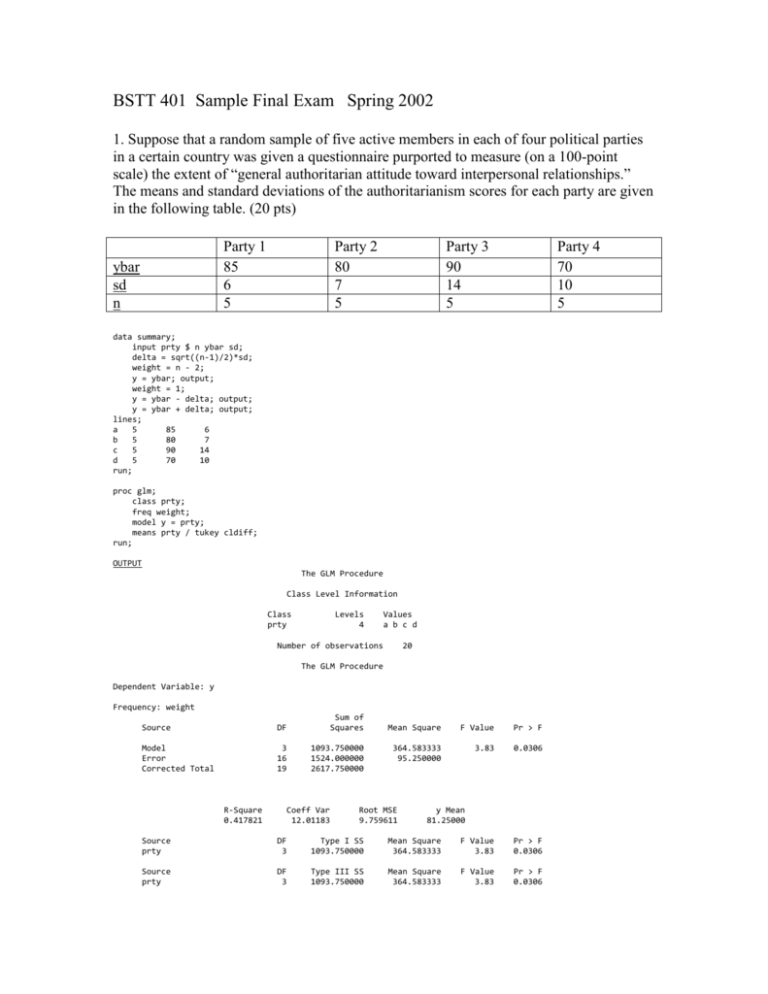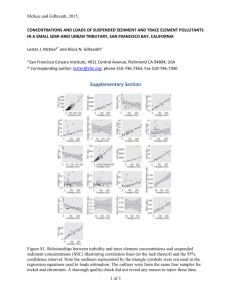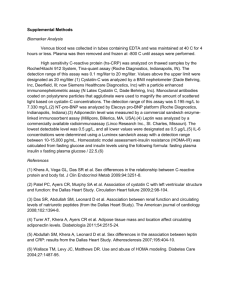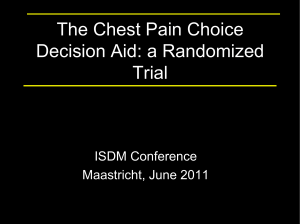Sample Final
advertisement

BSTT 401 Sample Final Exam Spring 2002 1. Suppose that a random sample of five active members in each of four political parties in a certain country was given a questionnaire purported to measure (on a 100-point scale) the extent of “general authoritarian attitude toward interpersonal relationships.” The means and standard deviations of the authoritarianism scores for each party are given in the following table. (20 pts) Party 1 85 6 5 ybar sd n Party 2 80 7 5 Party 3 90 14 5 Party 4 70 10 5 data summary; input prty $ n ybar sd; delta = sqrt((n-1)/2)*sd; weight = n - 2; y = ybar; output; weight = 1; y = ybar - delta; output; y = ybar + delta; output; lines; a 5 85 6 b 5 80 7 c 5 90 14 d 5 70 10 run; proc glm; class prty; freq weight; model y = prty; means prty / tukey cldiff; run; OUTPUT The GLM Procedure Class Level Information Class prty Levels 4 Values a b c d Number of observations 20 The GLM Procedure Dependent Variable: y Frequency: weight Source DF Sum of Squares Model Error Corrected Total 3 16 19 1093.750000 1524.000000 2617.750000 R-Square 0.417821 Coeff Var 12.01183 Mean Square F Value Pr > F 364.583333 95.250000 3.83 0.0306 Root MSE 9.759611 y Mean 81.25000 Source prty DF 3 Type I SS 1093.750000 Mean Square 364.583333 F Value 3.83 Pr > F 0.0306 Source prty DF 3 Type III SS 1093.750000 Mean Square 364.583333 F Value 3.83 Pr > F 0.0306 The GLM Procedure Tukey's Studentized Range (HSD) Test for y NOTE: This test controls the Type I experimentwise error rate. Alpha Error Degrees of Freedom Error Mean Square Critical Value of Studentized Range Minimum Significant Difference 0.05 16 95.25 4.04609 17.66 Comparisons significant at the 0.05 level are indicated by ***. prty Comparison c c c a a a b b b d d d - Difference Between Means a b d c b d c a d c a b 5.000 10.000 20.000 -5.000 5.000 15.000 -10.000 -5.000 10.000 -20.000 -15.000 -10.000 Simultaneous 95% Confidence Limits -12.660 -7.660 2.340 -22.660 -12.660 -2.660 -27.660 -22.660 -7.660 -37.660 -32.660 -27.660 22.660 27.660 37.660 12.660 22.660 32.660 7.660 12.660 27.660 -2.340 2.660 7.660 *** *** a. State the model for the experiment, using dummy variables. b. State the hypotheses. c. Test to see where significant differences exist among parties with respect to mean authoritarian scores. d. Based on Tukey’s method of multiple comparisons, identify the pairs in which the means significantly differ from one another. (Use alpha = .05) 2. The diameters (Y) of three species of pine trees (A) were compared at each of four locations (B), using samples of three trees per species at each location. Here A is considered fixed and B, random. The resulting data are given in the data in the following SAS program. (15 pts) data mixed; input A B @@; do i = 1 to 3; input yield @@; output; end; drop i; cards; 1 1 1 1 2 2 2 2 3 3 3 3 ; 1 2 3 4 1 2 3 4 1 2 3 4 15.71 16.21 17.32 17.54 17.83 17.68 17.95 18.08 14.78 15.80 16.21 16.99 16.02 16.36 17.03 17.82 17.45 17.70 18.01 18.56 15.03 15.62 16.44 16.39 15.90 16.33 17.22 17.62 16.96 17.52 18.41 18.90 14.63 15.77 16.32 17.02 proc glm; Title ‘when A is fixed and B is random’; class A B; model yield = A B A*B; random B A*B/test; run; Output WHEN A IS FIXED AND B IS RANDOM The GLM Procedure Class Level Information Class A B Levels Values 3 1 2 3 4 1 2 3 4 Number of observations 36 The GLM Procedure Dependent Variable: yield Source DF Sum of Squares Model Error Corrected Total 11 24 35 39.06083056 1.39026667 40.45109722 R-Square 0.965631 Coeff Var 1.427132 Mean Square F Value Pr > F 3.55098460 0.05792778 61.30 <.0001 Root MSE 0.240682 yield Mean 16.86472 Source A B A*B DF 2 3 6 Type I SS 24.31027222 13.81794167 0.93261667 Mean Square 12.15513611 4.60598056 0.15543611 F Value 209.83 79.51 2.68 Pr > F <.0001 <.0001 0.0389 Source A B A*B DF 2 3 6 Type III SS 24.31027222 13.81794167 0.93261667 Mean Square 12.15513611 4.60598056 0.15543611 F Value 209.83 79.51 2.68 Pr > F <.0001 <.0001 0.0389 The GLM Procedure Source A B A*B Type III Expected Mean Square Var(Error) + 3 Var(A*B) + Q(A) Var(Error) + 3 Var(A*B) + 9 Var(B) Var(Error) + 3 Var(A*B) The GLM Procedure Tests of Hypotheses for Mixed Model Analysis of Variance Dependent Variable: yield Source DF Type III SS Mean Square F Value Pr > F 2 3 6 24.310272 13.817942 0.932617 12.155136 4.605981 0.155436 78.20 29.63 <.0001 0.0005 Source DF Type III SS Mean Square F Value Pr > F A*B Error: MS(Error) 6 24 0.932617 1.390267 0.155436 0.057928 2.68 0.0389 A B Error: MS(A*B) a. State the model b. State the three possible hypotheses. c. Test to see where significant differences exist among species, locations as well as the interactions with respect to mean diameters of the trees. 3. 11 students were asked about their attitude toward biostatistics before and after taking BSTT401. (10 pts) BSTT 401 Column totals Before After Opinion about biostatistics Like Dislike 2 9 7 4 9 13 Row totals 11 11 22 Here the problem is that the number of students who answered the question is not 22 but 11. Each student answered the question twice before and after taking BSTT401. Therefore, each observation is not independent. Three students said that they disliked the biostatistics before and after taking the class. a. Construct a table about the pairs of responses. After Like Before Like Dislike Column totals Row totals Dislike b. Calculate McNemar’s Test Statistics and see whether their attitude toward biostatistics significantly changed or not. (refer to the fact that the critical value of X 2 with one degree of freedom at =.05 is 3.841). 4. Suppose we want to find out the relationship between lung cancer and BMI and the following data have been collected. (20 pts) BMI Above 30 (Obese) 25 – 30 (Overweight) Below 25 (Normal) Heart attacks Yes 20 10 5 SAS program Data cancer; input bmi $ attack $ wt; if bmi= ‘obese’ then X1 = 1; else X1=0; if bmi= ‘overwt’ then X2 = 1; else X2 = 0; if attack = ‘yes’ then Y = 1 ; else Y = 0; lines; obese yes 25 obese no 5 overwt yes 10 overwt no 20 normal yes 5 normal no 25 run; proc logistic descending; weight wt; model Y = X1 X2 /link=logit; run; Output The LOGISTIC Procedure Model Information No 5 20 25 Data Set Response Variable Number of Response Levels Number of Observations Weight Variable Sum of Weights Link Function Optimization Technique WORK.CANCER Y 2 6 wt 90 Logit Fisher's scoring Response Profile Total Y Frequency 1 3 0 3 Ordered Value 1 2 Total Weight 40.000000 50.000000 Model Convergence Status Convergence criterion (GCONV=1E-8) satisfied. Model Fit Statistics Intercept Intercept and Criterion Only Covariates AIC 125.653 98.258 SC 125.445 97.633 -2 Log L 123.653 92.258 Testing Global Null Hypothesis: BETA=0 Test Likelihood Ratio Score Wald Chi-Square 31.3949 29.2500 23.3637 DF 2 2 2 Pr > ChiSq <.0001 <.0001 <.0001 The LOGISTIC Procedure Parameter Intercept X1 X2 Analysis of Maximum Likelihood Estimates Standard DF Estimate Error Chi-Square 1 1 1 -1.6093 3.2186 0.9162 0.4899 0.6928 0.6245 Pr > ChiSq 10.7921 21.5842 2.1523 0.0010 <.0001 0.1424 Odds Ratio Estimates Effect X1 X2 Point Estimate 95% Wald Confidence Limits 24.994 2.500 6.429 0.735 97.170 8.500 Association of Predicted Probabilities and Observed Responses Percent Concordant Percent Discordant Percent Tied Pairs 33.3 33.3 33.3 9 Somers' D Gamma Tau-a c 0.000 0.000 0.000 0.500 a) State the model. b) Based on G 2 statistics, state whether the model is significant or not. c) Find OR Obese vs Normal , and its confidence interval and interpret the result. d) Find OR Overweight vs Normal and its confidence interval and interpret the result. 5. The objective of this study is to compare incidence of nonmelanoma skin cancer among women in Minneapolis-St. Paul and Dallas-Ft. Worth. (15 pts) SAS program data skin1; input agegroup $ city $ cases pop @@; lpop = log(pop); if agegroup='15-24' then age1=1; else age1=0; if agegroup='25-34' then age2=1; else age2=0; if agegroup='35-44' then age3=1; else age3=0; if agegroup='45-54' then age4=1; else age4=0; if agegroup='55-64' then age5=1; else age5=0; if agegroup='65-74' then age6=1; else age6=0; if agegroup='75-84' then age7=1; else age7=0; if city='Dallas' then city1=1; else city1=0; lines; 15-24 Paul 1 172675 25-34 Paul 16 123065 35-44 Paul 30 96216 45-54 Paul 71 92051 55-64 Paul 102 72159 65-74 Paul 130 54722 75-84 Paul 133 32185 85+ Paul 40 8328 run; 15-24 25-34 35-44 45-54 55-64 65-74 75-84 85+ Dallas Dallas Dallas Dallas Dallas Dallas Dallas Dallas 4 38 119 221 259 310 226 65 181343 146207 121374 111353 83004 55932 29007 7538 proc genmod; model cases = age1 age2 age3 age4 age5 age6 age7 city1 /dist=poisson link = log offset=lpop /* to normalize the fitted cell type1 type3; run; Output The GENMOD Procedure Model Information Data Set WORK.SKIN2 Distribution Poisson Link Function Log means */ Dependent Variable Offset Variable Observations Used cases lpop 16 Criteria For Assessing Goodness Of Fit Criterion DF Value Value/DF Deviance Scaled Deviance Pearson Chi-Square Scaled Pearson X2 Log Likelihood Algorithm converged. 7 7 7 7 8.1950 8.1950 8.0626 8.0626 7201.8635 1.1707 1.1707 1.1518 1.1518 Using EXCEL, the p-value for D is .316. Analysis Of Parameter Estimates Parameter DF Estimate Standard Error Intercept age1 age2 age3 age4 age5 age6 age7 city1 Scale 1 1 1 1 1 1 1 1 1 0 -5.4797 -6.1782 -3.5480 -2.3308 -1.5830 -1.0909 -0.5328 -0.1196 0.8043 1.0000 0.1037 0.4577 0.1675 0.1275 0.1138 0.1109 0.1086 0.1109 0.0522 0.0000 Wald 95% Confidence Limits -5.6828 -7.0753 -3.8763 -2.5807 -1.8061 -1.3083 -0.7457 -0.3371 0.7020 1.0000 -5.2765 -5.2810 -3.2197 -2.0810 -1.3599 -0.8735 -0.3199 0.0978 0.9066 1.0000 ChiSquare Pr > ChiSq 2794.67 182.17 448.76 334.36 193.38 96.75 24.06 1.16 237.34 <.0001 <.0001 <.0001 <.0001 <.0001 <.0001 <.0001 0.2809 <.0001 OTE: The scale parameter was held fixed. LR Statistics For Type 1 Analysis ChiSource Deviance DF Square Intercept 2790.3403 age1 1808.1517 1 982.19 age2 1115.2415 1 692.91 age3 708.1006 1 407.14 age4 455.6933 1 252.41 age5 306.8205 1 148.87 age6 268.0675 1 38.75 age7 266.9143 1 1.15 city1 8.1950 1 258.72 Pr > ChiSq <.0001 <.0001 <.0001 <.0001 <.0001 <.0001 0.2829 <.0001 LR Statistics For Type 3 Analysis ChiSource DF Square Pr > ChiSq age1 1 626.74 <.0001 age2 1 418.90 <.0001 age3 1 252.07 <.0001 age4 1 145.04 <.0001 age5 1 78.00 <.0001 age6 1 21.50 <.0001 age7 1 1.14 0.2862 city1 1 258.72 <.0001 a) State the model b) Based on D statistics, state whether the model fits the data well or not. c) Find RR Dallas vs Paul and interpret the result. 6. From the same context with Problems 1 & 2, subjects 1-8 came from Clinic A, subjects 9 –15, from Clinic B, and subjects 16-20 from Clinic C were added later. (10 pts) Subject 1 2 3 4 5 6 7 8 Clinic A 1.69 2.22 3.07 3.35 3.00 2.74 3.61 5.14 Subject 9 10 11 12 13 14 15 Clinic B 2.44 4.17 2.42 2.94 3.04 4.62 4.42 Subject 16 17 18 19 20 title1 'Nonparametric problem 3'; data one; input subject before after @@; if subject < 9 then clinic="A"; if subject > 8 and subject < 16 then clinic="B"; if subject > 15 then clinic="C"; drop before; cards; 1 1.69 1.69 9 2.58 2.44 2 2.77 2.22 10 1.84 4.17 3 1.00 3.07 11 1.89 2.42 4 1.66 3.35 12 1.91 2.94 5 3.00 3.00 13 1.75 3.04 6 0.85 2.74 14 2.46 4.62 7 1.42 3.61 15 2.35 4.42 8 2.82 5.14 16 . 2.34 17 . 3.17 18 . 4.42 19 . 4.94 20 . 5.04 ; run; proc npar1way wilcoxon; class clinic; var after; run; Edited SAS output The NPAR1WAY Procedure Wilcoxon Scores (Rank Sums) for Variable after Classified by Variable clinic Sum of Expected Std Dev Mean clinic N Scores Under H0 Under H0 Score ƒƒƒƒƒƒƒƒƒƒƒƒƒƒƒƒƒƒƒƒƒƒƒƒƒƒƒƒƒƒƒƒƒƒƒƒƒƒƒƒƒƒƒƒƒƒƒƒƒƒƒƒƒƒƒƒƒƒƒƒƒƒƒƒƒƒƒƒƒƒ A 8 72.00 84.00 12.956608 9.000000 B 7 71.50 73.50 12.614684 10.214286 C 5 66.50 52.50 11.452131 13.300000 Average scores were used for ties. Kruskal-Wallis Test Chi-Square 1.6519 Clinic C 2.34 3.17 4.42 4.94 5.04 DF Pr > Chi-Square 2 0.4378 Can one conclude that the FEV levels from these three groups are different? Let 0.05 and find the p-value. 7. Assume that the following table came from the analysis of a randomized-blocks design ANOVA. (10 pts) Source Treatments df 4 SS b MS e F 5.00 Blocks a c 48.00 6.00 Error 20 d f Show your work on how you got the answers for a) – f).




